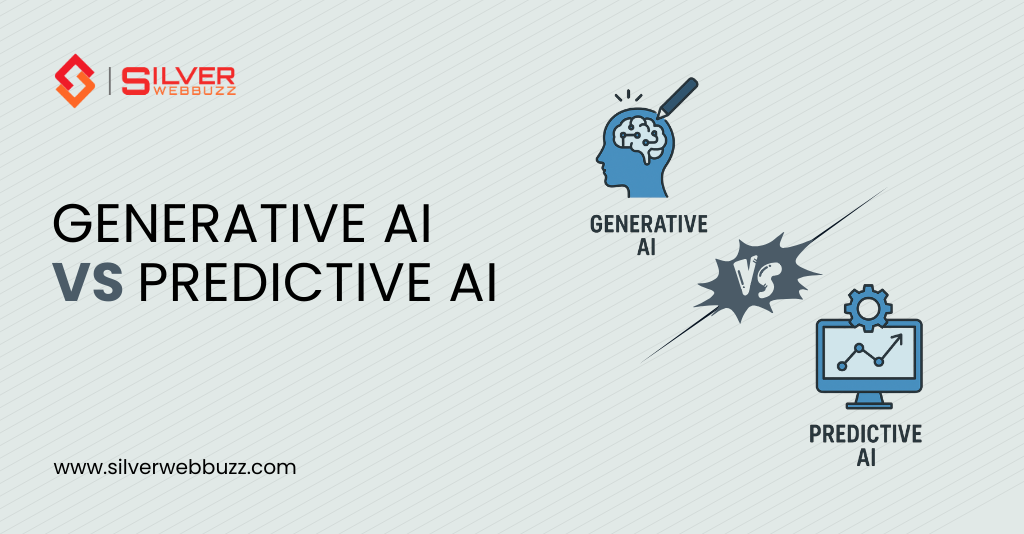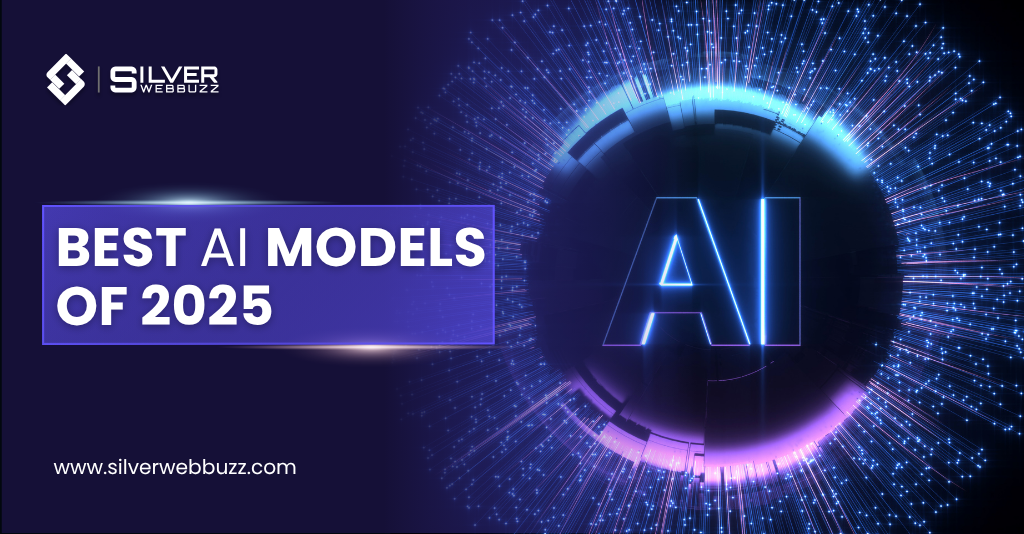Artificial Intelligence (AI) is transforming the way businesses innovate, create, and make decisions. Two of the most talked-about approaches are Generative AI and Predictive AI. While they sound similar, they solve very different problems. If you’ve ever wondered which type of AI powers ChatGPT versus which powers your bank’s fraud detection, this guide is for you.
In this article, you’ll learn exactly what Generative AI and Predictive AI are, how they differ, where they overlap, and how to choose the right one for your business. Whether you’re a student, a tech leader, or an entrepreneur in the USA, this complete guide breaks it down step by step.
What is Generative AI?
Generative AI is a branch of artificial intelligence that focuses on creating new content rather than simply analyzing existing data. Instead of predicting an outcome, it generates something original — text, images, code, music, or even 3D designs.
At its core, Generative AI relies on large datasets and advanced models to learn patterns and structures. Once trained, it can produce outputs that look and feel like humans created them.
Key Features of Generative AI
- Content Creation: Produces text, images, audio, video, or code.
- Pattern Understanding: Learns how things “should” look or sound based on training data.
- Creativity at Scale: Automates tasks like copywriting, design, and ideation.
- Interactive Capabilities: Powers chatbots, virtual assistants, and creative tools.
Popular Generative AI Models
| Model Type | What It Does | Examples |
|---|---|---|
| Large Language Models (LLMs) | Generates text, answers questions, writes code. | ChatGPT, Claude, Gemini |
| Diffusion Models | Creates high-quality images from text prompts. | DALL·E, Midjourney, Stable Diffusion |
| Generative Adversarial Networks (GANs) | Generates realistic images, video, or voice. | Deepfake generators, image upscalers |
| Transformers for Multimodal Output | Combines text, image, and audio creation. | Runway, Synthesia, Adobe Firefly |
Real-World Examples of Generative AI
- Content Marketing: Writing blog posts, product descriptions, ad copy.
- Design & Creativity: Generating logos, concept art, and product mockups.
- Healthcare & Pharma: Designing new molecules for drug discovery.
- Entertainment: Composing music, creating video scripts, or animating characters.
Why It’s Important
Generative AI accelerates creativity and innovation. Businesses use it to save time, reduce costs, and scale content production. However, it’s only as good as the data and ethical guardrails placed around it.
What is Predictive AI?
Predictive AI is a type of artificial intelligence focused on forecasting outcomes based on historical data. Instead of creating new content, it analyzes past patterns to predict future events.
This approach is common in industries where decision-making depends on accurate forecasting — from finance to healthcare to retail.
Key Features of Predictive AI
- Forecasting Outcomes: Uses statistical and machine learning models to predict what’s likely to happen next.
- Data-Driven Decision-Making: Leverages large datasets to find trends and patterns.
- Risk Mitigation: Helps businesses reduce uncertainty and act proactively.
- Automation of Insights: Speeds up reporting and analysis for decision-makers.
Popular Predictive AI Techniques
| Technique | What It Does | Examples |
|---|---|---|
| Regression Models | Predicts continuous outcomes like sales or revenue. | Forecasting monthly sales |
| Classification Models | Identifies which category a new data point belongs to. | Fraud detection, churn prediction |
| Time-Series Analysis | Forecasts trends over time. | Stock prices, demand planning |
| Ensemble Models | Combines multiple algorithms for better accuracy. | Random forests, gradient boosting |
Real-World Examples of Predictive AI
- Retail & E-Commerce: Predicting customer churn, inventory needs, and demand trends.
- Banking & Finance: Fraud detection, credit scoring, loan default prediction.
- Healthcare: Patient risk scoring, disease outbreak prediction, hospital resource planning.
- Manufacturing: Predictive maintenance of machinery to prevent downtime.
Why It’s Important
Predictive AI reduces uncertainty and improves decision quality. Businesses use it to plan, optimize resources, and increase profitability. While it doesn’t create new content, its power lies in anticipating future outcomes based on data you already have.
Generative AI vs Predictive AI: Key Differences
Although both Generative AI and Predictive AI rely on machine learning, their goals, methods, and outcomes are very different. Understanding these distinctions will help you decide which one fits your business needs.
1. Core Purpose
- Generative AI focuses on creating new data or content. It learns from existing information and produces something original, like an article, an image, or a code snippet.
- Predictive AI focuses on forecasting future outcomes. It uses patterns in existing data to anticipate what is likely to happen next.
2. Data Usage
- Generative AI: Learns the structure of data (such as text or images) to create new examples that look similar to the original.
- Predictive AI: Looks for patterns, trends, and correlations in historical data to make accurate forecasts.
Underlying Technologies
| Aspect | Generative AI | Predictive AI |
|---|---|---|
| Main Algorithms | Large Language Models (LLMs), Generative Adversarial Networks (GANs), Diffusion Models | Regression, Classification, Time-Series, Ensemble Models |
| Data Focus | Representation learning and pattern replication | Feature engineering and outcome prediction |
| Output | Text, images, videos, or other synthetic data | Probability scores, predictions, or recommended actions |
Typical Business Use Cases
| Generative AI | Predictive AI |
|---|---|
| Writing blog posts, generating ad copy | Forecasting sales, predicting churn |
| Designing product mockups or art assets | Identifying fraud or risk in transactions |
| Automating code generation | Predictive maintenance of machines |
| Creating chatbots and virtual assistants | Forecasting inventory demand |
Expert Insight
Think of Generative AI as a digital artist, while Predictive AI is a digital fortune-teller. One creates something entirely new; the other predicts what’s likely to happen. Many businesses find value in using both together — for example, generating new product concepts (Generative AI) and forecasting demand for them (Predictive AI).
Predictive AI vs Generative AI: Understanding the Reverse Perspective
When comparing AI types, most people start by asking how Generative AI differs from Predictive AI. But flipping the question — looking at Predictive AI vs Generative AI — helps reveal how these two approaches complement each other from a business and strategy standpoint.
Why Reverse the Perspective?
By viewing Predictive AI as the starting point, you see how it lays the foundation for data-driven decision-making, which Generative AI can then build upon. Predictive AI answers “what’s likely to happen,” while Generative AI answers “what could we create to respond?”
How Predictive AI Feeds Generative AI
- Data Insights → Creativity: Predictive AI analyzes customer trends or market shifts, and Generative AI uses those insights to create new content, products, or campaigns.
- Risk Awareness → Innovation: Predictive AI identifies potential risks, and Generative AI generates creative solutions or mitigation strategies.
- Optimization → Personalization: Predictive AI segments audiences or forecasts demand, enabling Generative AI to craft personalized messages or offers.
Practical Examples
| Predictive AI Identifies | Generative AI Creates |
|---|---|
| High-risk customer churn | Personalized retention emails |
| Market demand for eco-friendly products | New product concepts or marketing visuals |
| Trend of rising interest in a topic | Blog posts, social media content, or ad creatives |
Benefits of Starting with Predictive AI
- Evidence-Based Creativity: Instead of guessing what to create, you’re informed by data.
- Better ROI: Content or products generated are more likely to succeed because they align with real-world demand.
- Reduced Waste: Avoids spending time and money creating things no one wants.
Takeaway
Looking at Predictive AI vs Generative AI isn’t just semantics — it’s a strategic way to connect forecasting with creativity. Predictive AI sets the stage by telling you what’s needed; Generative AI delivers by creating it.
Generative vs Predictive AI: How They Complement Each Other
While Generative AI and Predictive AI seem like opposites, they actually work best together. Think of Predictive AI as the analyst and Generative AI as the creator. When combined, they enable businesses to move from insight to action seamlessly.
The Symbiotic Relationship
- Predictive AI identifies trends; Generative AI acts on them.
- Predictive AI reduces uncertainty; Generative AI explores new possibilities.
- Predictive AI delivers the “what”; Generative AI delivers the “how.”
Key Areas Where They Work Together
| Process Step | Predictive AI Role | Generative AI Role |
|---|---|---|
| Market Analysis | Forecast demand, segment customers. | Generate personalized marketing messages or product concepts. |
| Product Development | Predict which features users will want. | Create prototypes, mockups, or UI concepts. |
| Customer Support | Predict common questions or issues. | Generate automated replies or knowledge base content. |
| Risk Management | Identify potential threats or failures. | Create scenarios, simulations, or mitigation plans. |
Business Scenario: From Insight to Innovation
- Step 1: Predictive AI forecasts that demand for eco-friendly packaging will grow 30% next quarter.
- Step 2: Generative AI designs new packaging concepts and marketing visuals aligned with the trend.
- Step 3: Predictive AI models expected sales for each concept.
- Step 4: Generative AI generates personalized ad copy and campaign creatives to launch.
This cycle enables companies to test ideas more quickly, mitigate risk, and optimise ROI.
Why This Matters for Businesses
- Better Strategic Planning: Insights inform creativity instead of guesswork.
- Faster Go-to-Market: Predictive analysis plus generative creation cuts time from concept to launch.
- Stronger Competitive Edge: Combines the strengths of data science and creative AI.
Takeaway
By leveraging Generative and Predictive AI together, organizations can move beyond just knowing what might happen to actively creating solutions for it. This combination is becoming the new standard for innovation-driven companies.
Generative AI vs Predictive AI: Benefits and Limitations
Both Generative AI and Predictive AI deliver major value, but in different ways. Understanding their strengths and weaknesses helps you choose the right one — or combine them effectively.
Benefits of Generative AI
- Accelerates Content Creation: Produces text, images, videos, and code at scale.
- Enhances Creativity: Generates new ideas, designs, and product concepts.
- Personalizes Experiences: Creates custom recommendations, chat responses, and ad creatives.
- Saves Time & Costs: Automates labor-intensive creative tasks.
Limitations of Generative AI
- Accuracy Risks: Outputs may include errors or “hallucinations.”
- Bias Concerns: Reflects biases in training data if not carefully managed.
- Ethical & Copyright Issues: Ownership of AI-generated content is still evolving legally.
- High Resource Needs: Requires large datasets and computing power to train models.
Benefits of Predictive AI
- Improves Decision-Making: Forecasts future outcomes with data-driven insights.
- Reduces Risk: Identifies problems before they escalate.
- Optimizes Resources: Improves staffing, inventory, and operations planning.
- Supports Evidence-Based Strategy: Aligns business plans with real-world trends.
Limitations of Predictive AI
- Dependent on Historical Data: Can’t forecast well in rapidly changing or new scenarios.
- Limited Creativity: Provides probabilities but not new content or solutions.
- Model Drift: Accuracy drops if input data quality declines or market changes dramatically.
- Complexity in Implementation: Requires strong data infrastructure and expertise.
Difference Between Predictive and Generative AI in Real-World Applications
While the theory behind Predictive AI and Generative AI is important, the real-world use cases are where the difference becomes crystal clear. Here’s how each approach plays out across key industries.
Retail & E-Commerce
- Predictive AI: Forecasts demand, predicts customer churn, and optimizes inventory levels before peak seasons.
- Generative AI: Writes product descriptions, generates ad copy, creates lifestyle images for product pages.
Healthcare
- Predictive AI: Predicts patient readmission risk, disease outbreaks, or hospital resource needs.
- Generative AI: Designs new drug molecules, generates synthetic medical images for training, drafts patient communication templates.
Finance & Banking
- Predictive AI: Detects fraudulent transactions, forecasts credit risk, and scores loan applicants.
- Generative AI: Generates personalized investment reports, creates automated customer service chatbots, and simulates financial scenarios.
Manufacturing
- Predictive AI: Anticipates equipment failures for predictive maintenance, optimizes supply chain operations.
- Generative AI: Creates digital twins of production lines, designs new product prototypes, and generates training manuals automatically.
Marketing & Advertising
- Predictive AI: Identifies the best time and channel to reach a customer or predict campaign ROI.
- Generative AI: Creates ad visuals, headlines, social media content, and personalized email campaigns at scale.
Education & Training
- Predictive AI: Forecasts student performance or dropout risk.
- Generative AI: Creates custom lesson plans, quizzes, and virtual tutors tailored to learning styles.
Generative AI vs. Predictive AI: Which One Should Businesses Choose?
Choosing between Generative AI and Predictive AI isn’t about which is “better” — it’s about which best fits your business goals. In many cases, the smartest move is to use both together.
Key Factors to Consider
1. Business Objective
- If you need to forecast trends, demand, or risk, start with Predictive AI.
- If you want to create new content, automate creativity, or design products, start with Generative AI.
2. Data Availability
- Predictive AI needs high-quality historical data.
- Generative AI needs large, diverse datasets for training on content types.
3. Output Type
- Predictive AI outputs numbers, probabilities, and recommendations.
- Generative AI outputs text, visuals, audio, or entirely new designs.
4. ROI Timeline
- Predictive AI often shows quicker, measurable ROI by improving decisions.
- Generative AI delivers creative and engagement-focused ROI that may take longer to measure.
When to Choose Predictive AI
- Forecasting sales or demand.
- Risk management and fraud detection.
- Operational optimization (inventory, staffing, logistics).
When to Choose Generative AI
- Automating content creation or marketing campaigns.
- Designing new products, visuals, or experiences.
- Personalizing user interactions with chatbots or dynamic content.
When to Combine Them
- Example: Predictive AI identifies a new market segment → Generative AI produces personalized campaigns for that segment.
- Example: Predictive AI forecasts high churn risk → Generative AI drafts customized retention messages.
Future Outlook: How Generative and Predictive AI Will Evolve Together
The line between Generative AI and Predictive AI is already starting to blur. As technology advances, these two approaches will increasingly merge into hybrid systems that both predict and create, transforming how businesses operate.
1. Convergence of Generative + Predictive AI
- Smarter Systems: Future AI platforms will automatically forecast outcomes and generate solutions in real time.
- Closed-Loop Innovation: Predictive models will inform generative engines, which will then create optimized content or actions, feeding back into the prediction cycle.
- Industry-Specific AI: Expect niche AI systems tailored for retail, healthcare, finance, and manufacturing with built-in predictive + generative capabilities.
2. Key Emerging Trends
- AI Agents with Autonomy: Systems that can both decide what needs to be done and create it.
- Multimodal Intelligence: Text, image, audio, and sensor data combined to deliver richer insights and creative outputs.
- Ethics and Governance: New frameworks to address data privacy, bias, and intellectual property as AI-generated content becomes mainstream.
- Accessible AI Tools: More user-friendly tools enabling small businesses to harness both predictive and generative power without coding expertise.
3. Opportunities for Businesses
- Faster Product Cycles: Predict → Generate → Test → Predict again.
- Hyper-Personalization: Predictive AI segments audiences, Generative AI creates content for each segment automatically.
- New Business Models: Subscription-based “AI-as-a-service” platforms combining both prediction and generation.
4. Challenges Ahead
- Data Quality & Privacy: Stronger safeguards will be essential.
- Bias & Transparency: More demand for explainable AI models.
- Integration Complexity: Combining predictive and generative tools requires well-structured data pipelines.
Conclusion: Choosing the Right AI Approach
Generative AI and Predictive AI are not competitors — they’re complementary. Predictive AI delivers foresight and data-driven insights, while Generative AI brings creativity and innovation to life. Together, they help businesses forecast trends, create tailored experiences, and accelerate growth.
When choosing your AI approach, focus on your business goals, data readiness, and desired outcomes. Companies that integrate both predictive and generative strategies will gain a powerful edge in the evolving AI landscape.




